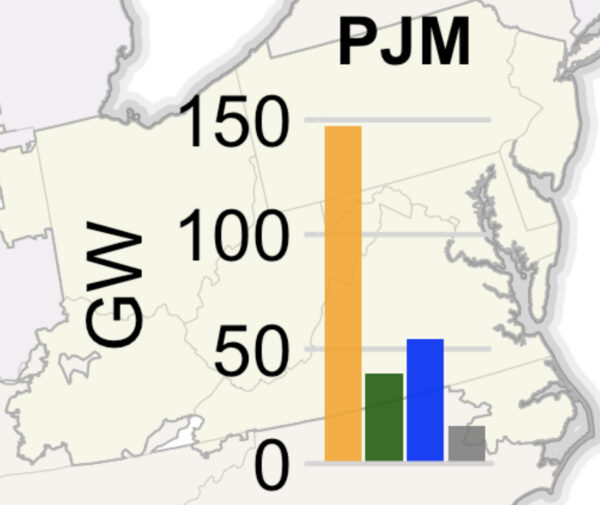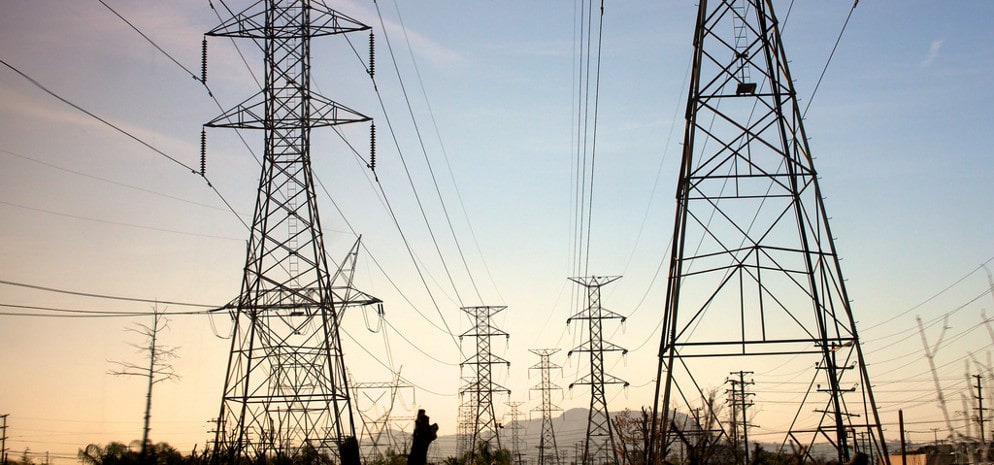The grid operator PJM projects that 48 GW of solar and wind capacity will be added across the 13-state grid region by 2030 in a “low” scenario. That amount would be “insufficient to keep up with” expected generator retirements and demand growth, PJM said.
In a “high” scenario, PJM projects 94 GW of added solar and wind capacity by 2030, plus 9 GW of added gas capacity, saying that at these levels, “resource adequacy would be maintained.” PJM presented both scenarios in a report forecasting resource adequacy and reliability, as the PJM grid’s generating mix changes.
PJM’s analysis was questioned by Elise Caplan, vice president of regulatory affairs for renewables trade group ACORE, and Ric O’Connell, executive director of the consultancy GridLab.
Caplan questioned PJM’s projection of future renewables growth in the grid region based on what PJM termed a “historical rate of completion” of about 5% for renewables projects, “from queue to steel in the ground.”
That historical pattern, Caplan said, is “highly unlikely to continue due to the interconnection queue reforms that PJM is implementing and new federal incentives through the Inflation Reduction Act, both of which are likely to accelerate the rate of renewable and storage development.”
“ACORE is pleased,” Caplan added, that Federal Energy Regulatory Commission Chairman Willie L. Phillips has announced a forum to discuss the PJM capacity market, “which will provide an opportunity to address in-depth” the rate of renewable and storage development, as well as the “poor performance” of thermal resources during extreme weather events and “the reliability benefits of transmission expansion.”
O’Connell said in a Twitter thread that “PJM asserts that it can’t get projects online fast enough to meet a forecast resource adequacy gap. The tone of the report implies this is an external problem,” yet hundreds of gigawatts of projects “are waiting in a queue that PJM has shut down.”
“PJM is wholly in charge of planning the network backbone that could bring enough generation online to meet the 2030 needs,” he continued. “It could be proactively doing that planning, instead of using past performance to worry about the future.”
“The take-away of this report should not be ‘oh, no, we can’t get enough online in time,’” he said. “It should be ‘what do we need to do to get all this clean energy waiting in the queue online so we can meet our future needs?’”
PJM’s queue and progress
PJM now has 290 GW of renewables projects waiting in its interconnection queue, it said in its report. That’s an increase from year-end 2021, when the queue included about 150 GW of solar projects, 40 GW of wind projects, and 50 GW of storage projects, as shown in the nearby image from Berkeley Lab. PJM’s queue is currently closed to new projects.

Responding to a question about its interconnection queue progress, PJM said that in 2022 it issued to project developers either a final Interconnection Service Agreement or a Wholesale Market Participation Agreement for a total of 9.6 GW of solar projects, 1.3 GW of solar-plus-storage projects, and 0.6 GW of storage projects.
Under the first type of agreement, a project developer would commit to pay for, and transmission owners would commit to build, the transmission system upgrades needed to connect the project to the grid. The second type of agreement allows the owner of a project connected to the distribution grid to sell energy and/or capacity into the PJM markets.
In comparison to PJM’s combined data for projects seeking interconnection and projects already connected to the distribution grid, ERCOT, the fastest-moving regional grid operator in the U.S., completed final facilities studies for 15 GW of solar projects last year, although it is less than half the size of PJM.
All 13 states in the PJM grid region have called for PJM to make faster progress on interconnection.
In a story for the New York Times, reporter Brad Plumer quoted a PJM system planner who said PJM faces the challenge of a limited number of power engineers capable of conducting interconnection studies—a concern that has also been raised by two other grid operators.
PJM Interconnection is a regional transmission organization that serves approximately 65 million people in 13 states and the District of Columbia. PJM’s report is titled “Energy transition in PJM: Resource retirements, replacements and risks.”
This content is protected by copyright and may not be reused. If you want to cooperate with us and would like to reuse some of our content, please contact: editors@pv-magazine.com.








By submitting this form you agree to pv magazine using your data for the purposes of publishing your comment.
Your personal data will only be disclosed or otherwise transmitted to third parties for the purposes of spam filtering or if this is necessary for technical maintenance of the website. Any other transfer to third parties will not take place unless this is justified on the basis of applicable data protection regulations or if pv magazine is legally obliged to do so.
You may revoke this consent at any time with effect for the future, in which case your personal data will be deleted immediately. Otherwise, your data will be deleted if pv magazine has processed your request or the purpose of data storage is fulfilled.
Further information on data privacy can be found in our Data Protection Policy.